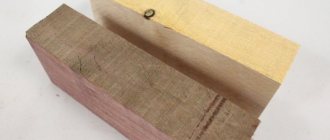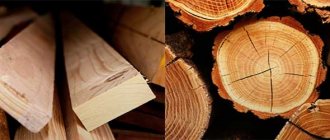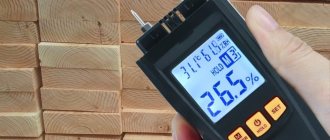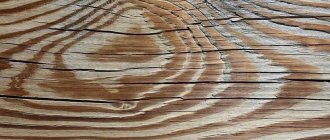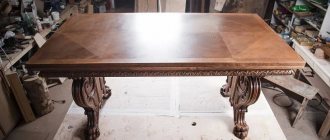The problem of preserving a wooden home, wooden furniture and other wood products has always existed. Especially where the humid climate contributes to the active prosperity of mold, fungi, putrefactive bacteria and other destructive biological factors. Various methods are used to protect wood. In this article you can read about one of them - simple, but very effective and popular among home and professional craftsmen - oiling wood. After spending about 14 minutes viewing the material, you will learn about the advantages and disadvantages of the method, how to use it, what types of oils you can buy and which manufacturers to pay attention to.
What is wood oil and why is it used?
Let's start answering this question from the second part. The motivation for using oil on porous wood surfaces was the obvious physical characteristics of oily liquids:
- water repulsion - up to complete non-wetting of oil-impregnated materials;
- good penetration into capillary volumes, accompanied by displacement of air.
Oil impregnation applied to wood penetrates deeper into the wood structure, the lower the density of its species. Gradually the oil polymerizes, giving hardness to the coating. Since the access to moisture and oxygen is greatly limited, it is easy to guess that for the vast majority of microorganisms, oil-coated wood will not be a favorable habitat.
What is wood oil? First of all, it is worth saying that this is a liquid product that is used for the protection and decorative finishing of wooden structures and products. All types of oil are easy to use and, when chosen correctly, provide good results.
Applying oil to wood The composition of oil used to coat wood can vary. It can be just oil: vegetable, mineral, combined. Or modified oil, that is, with additives that enhance certain properties. Recently, complex oil-based formulations containing solvents and solid particles have been increasingly used.
For example, it is worth adding wax to the oil mixture, and the wood will receive, in addition to protective impregnation, a fairly thick and durable coating. If stabilization of wood with oils should not lead to the formation of a noticeable surface coating, solvents are added to the composition. They allow you to saturate the wood to the maximum possible depth.
Wood finishing oils
Kinds
Natural oils are strong antiseptics , penetrating deeply into wood fibers and increasing the water-repellent characteristics of the material. They provide reliable protection against drying out, good air exchange in the pores and regulation of wood moisture levels.
The oil is classified according to basic technical parameters : density, viscosity, amount of solids, type of volatile compounds present and special additives.
All this determines the performance characteristics of the coating and the technology for applying the composition to a specific type of wood.
types of oils for self-processing wood are :
- tung;
- tar;
- linen;
- teak;
- sunflower;
- Vaseline.
Tung
A safe and effective means of protecting wood surfaces from rot, mold and harmful insects. Tung oil is suitable for treating wood floors, ceilings, furniture and tableware . Its distinctive feature is the ability to quickly penetrate wood fibers and restore the original structure of lumber.
Before application, the impregnation is thoroughly mixed to obtain a homogeneous mass. The work is carried out in the warm season, when the air temperature is +14-15 degrees.
The oil is applied in an even thin layer using a narrow brush. Excess composition is removed with a clean rag or sponge along the fibers.
Degtyarnoe
A natural antiseptic composition that has long been used to protect wood from the negative effects of precipitation . Tar impregnation is made from stump resin, pine turpentine and linseed oil.
The composition is suitable for processing wooden boats, piers, log houses, gazebos, country houses and outdoor furniture.
Tar oil not only provides reliable protection against rotting, but also gives the wood an attractive transparent texture .
The application technology is similar to that provided for tung impregnation: the pre-cleaned surface is treated with a thoroughly mixed composition.
Important! Dilution of tar oil is strictly contraindicated.
Linen
This is the most accessible and cheapest product intended for external and internal work. Thanks to its excellent waterproofing characteristics, it is suitable for treating facades, ceilings, walls, furniture and decorative interior elements. It penetrates deeply into wood fibers, well emphasizes the original texture of the wood and forms a protective moisture-resistant coating on its surface.
The product contains triglycerides, which cause its drying time to increase three times compared to the above-mentioned impregnations.
Sunflower
In some cases, sunflower oil is used to quickly treat wooden surfaces. The low content of polyunsaturated fatty acids is not able to provide a coating effect to protect wood from rotting and damage.
Another negative characteristic of sunflower oil is the lack of polymerization, when it does not completely dry on the treated surface.
Vaseline
The organic formulation of saturated paraffinic carbon compounds is excellent for treating a variety of wood surfaces. Vaseline oil is odorless and colorless and allows you to emphasize the natural attractiveness of wood.
After the composition dries, a thin protective film with moisture-repellent properties is created on the surface. This coating is resistant to cracking and deformation .
Teak
Universal protective impregnation, which is intended for surface treatment:
- internal – floors, ceilings, walls, stairs, decorative elements, furniture;
- external - facades, gazebos, street furniture, benches, wooden surfaces.
Teak oil is environmentally friendly and safe product made from tung and linseed oil, as well as purified pine turpentine.
Important! Before application, such a composition must be stirred or shaken. It is forbidden to breed it .
Mineral
The mineral composition is used to treat deeply cleaned surfaces in industrial conditions. Mineral oil is rarely used at home and is only suitable for outdoor use.
To oil external decorative elements of structures and facades of non-residential buildings, a mixture of mineral and vegetable oil is used.
Note! Processing can be complicated by the fact that mineral compositions do not polymerize and are not susceptible to washing off .
Toning
Tinting impregnation forms a protective coating and gives the wood an attractive shade .
Such compositions are suitable for most types of wood, which are used in construction and decorative finishing.
The main components are natural pigments and a tinting base.
Danish
The product is intended to protect surfaces subject to rapid wetting and deformation . These include floors, walls, ceilings, tools and furniture.
Danish wood oil consists of a lacquer base, linseed oil and white spirit. Penetrating deeply into the structure, the composition provides reliable protection and gives the surface an attractive gloss.
Colored and white
Such oil impregnations are intended for treating surfaces damaged by insects or mold .
White oil is used for tinting when there is a desire to lighten the wood. It is perfect for painting walls, furniture or individual decorative elements.
The oil is a safe product because it does not contain toxic components .
Colored oils allow you to preserve the original characteristics of wood and give it the desired shade . They are suitable for painting lining, planed and sawn boards, and logs.
Where are wood oils used?
The short answer to this question is that any type of wood in any space can be treated with oil-based compounds. That is, the treatment of wooden surfaces with oil can be carried out indoors for various purposes, as well as outside buildings and other objects located in the open air. As a rule, different types of oil are used for work in different conditions. However, there are also universal formulations.
Use wood oils
Wood oil for interior work
The wooden surfaces to be treated with oil compositions indoors can include: walls, floors, ceilings, furniture, window frames, doors and other structural elements.
Wood oil for interior work The main requirement that applies to all types of oils for interior work is safety for health. Therefore, they are all made on a natural plant basis. Safe compounds are also used as solvents:
- completely natural - for example, gum turpentine;
- synthetic, containing a large amount of ether compounds, which completely volatilize as they polymerize and harden.
The next requirement for oil depends on how heavy the load the surface will bear. For example, if the cabinet walls have almost no such walls, then the countertop wears out quite quickly, and the parquet floor requires special reinforced protection. But wood is most at risk in rooms with high humidity - in the kitchen and even more so in the bathhouse.
Wood oil for interior work Here, in order to prevent destructive rotting under the influence of mold, both a high rate of polymerization, leading to hardening of the oil, and a protective film are necessary. Therefore, for example, the composition of the oil for protecting shelves in bathhouses and saunas includes driers that accelerate polymerization, as well as various types of wax involved in creating a protective film. At the same time, taking into account the inevitable contact of the wooden surface with the body, only natural ingredients that do not cause irritation and allergies were selected.
Wood oil Finally, weighing all the pros and
disadvantages of oil for wood of one type or another, it is necessary to take into account that it is not only protection, but also a decorative finish for a wooden surface. There are oils on the market with different shades and different tinting densities:
- absolutely colorless, completely preserving the natural texture of wood;
- containing pigments with varying degrees of intensity of natural shades: from weak yellowish to fairly dark gray-brown;
- compositions with different color pigments and varying degrees of matting.
The depth and expressiveness of the tone of oiled wood depends not only on the initial color of the oil, but also on the number of layers applied.
Wood oil
Wood oil for exterior use
The oil used to protect wood exposed to the open air does not have to be natural. Mineral oils are quite suitable for technical structures - warehouses, sheds, fences, etc. They are based on refined petroleum products. Combination formulations consisting of a mixture of vegetable and mineral oils are also often used.
Wood oil Special mineral and combined oil-based compositions, as well as some technical oils that are not intended but used for application to wood, are not environmentally friendly and are not intended for residential premises. But with them, the tree is reliably protected not only from rotting in unfavorable conditions, but also from insects and rodents.
Oil for wood In the case when the facade of a wooden building in which there are people is to be finished, the pros and cons of different types of oil coatings must be weighed especially carefully. Since human health always remains the main selection criterion, natural oil is predominantly chosen. However, it makes sense to apply a mineral or combined composition to certain areas, especially those located close to damp soil.
Oil for facade GOODHIM If mineral oil does not have high decorative properties, then natural oil gives the wood a very dignified appearance. Many modern compositions make it possible to apply a coating tinted in a variety of shades to its surface. For example, completely natural facade oil has 15 such shades.
How to protect wood
Many, especially novice craftsmen, ignore the process of protecting wood. But this approach entails many problems. It is no secret that wood absorbs moisture quite well. It is because of this property that undesirable consequences appear. Wooden products can dry out, crack, begin to rot, etc.
After putting a lot of effort into making a piece of furniture, you don’t want to end up with such a result. Therefore, to avoid damage to the product, you need to take time to protect it.
Often used means for impregnating wooden surfaces are oil and wax. They are able to reliably resist such negative factors as moisture, mold, mildew, rot and various kinds of insects. Along with this, they can increase the degree of strength and increase the service life of the product.
Use of oil
The list of oils used to treat wooden surfaces includes the following types:
- tung;
- teak;
- tar;
- linen
Wood processing oil has the following properties:
- antiseptic;
- the ability to penetrate deeply into the structure of the material;
- make wood more elastic;
- protect the tree from drying out;
- leaves the wood pores free, which allows the material to breathe and regulate the degree of humidity;
- it is not harmful to human health and is environmentally friendly.
Advice! Experts do not recommend impregnation with sunflower oil, although in desperate situations this is also an option. The fact is that sunflower contains quite a few polyunsaturated fatty acids. This also applies to olive oil.
Using wax
The use of wax is a time-tested method that was used by our great-grandfathers to protect wood. It protects it very well from moisture. The wax easily penetrates into the pores of the wood and also gives the surface a matte tint. But waxing has one drawback. Due to the fact that the pores are filled, the process of “breathing” of wood is completely absent.
Important! You should listen to the advice of masters who claim that it is better not to work with pure wax, but to add a certain amount of vegetable oil, for example, linseed oil, to it. Other ingredients, such as turpentine, will also not hurt.
On video: how to prepare a composition of wax and linseed oil.
What types of wood oils are there?
Let's start answering this question with what natural vegetable oil can be. The first most popular is flaxseed oil. More often, this definition refers to linseed oil, a modification of linseed oil that is more convenient for practical use. The advantages of this oil: excellent absorption and good polymerization ability. Disadvantage: polymerization is slow. However, the process is accelerated by exposure to UV rays. In this case, the coating darkens, which some also consider to be a disadvantage.
OSMO Azure
The best in all respects relative to flaxseed oil is the oil that is obtained from tung tree nuts or walnuts, as well as camelina and teak oil. However, due to their high cost, they are used much less frequently. Sunflower oil, hemp oil, soybean oil and others are significantly inferior to flaxseed oil and are used extremely rarely in their pure form. More often they are used as raw materials for the production of drying oil.
Terrace Tikkurila Valtti
An oil-based wood finish may contain oil, wax, natural resins, solvents, pigments, and more. Solid components such as wax and pigments are suspended. They are often called dry residue, because when the coating dries, they form a more or less noticeable protective and decorative layer. Oil containing a high percentage of solids is thick. It is more suitable for wood with large, visible grains. For hard wood species, in which the fibers are almost invisible and impregnation is difficult, liquid oils with a very low percentage of dry residue are used.
Facade oil GOODHIM
Important. For very hard wood species, oil with a high solids content is not used, because it is poorly absorbed and may subsequently peel off.
TIKKURILA SUPI for floors
Also, a big problem with absorption is typical for coniferous wood. As long as the essential oils of wood are felt, resin is released, which can penetrate through any coating. There is only one way out of the situation - degumming using solvent treatment.
BELINKA façade
All types of natural oils can be produced with different percentages of solids. Modern technologies now make it possible to obtain even solid oil with a solids content of 100%. As for mineral oils, the process of polymerization, that is, hardening, is especially difficult for them.
Terrace oil GOODHIM
As mentioned earlier, mineral oils for wood are refined derivatives of petroleum products. Cleaning is sometimes so good that a safe and odorless substance is obtained - for example, petroleum jelly. It is good for everyone, but it does not polymerize and, accordingly, does not harden.
BELINKA for sauna
However, even in non-polymerized form, petroleum mineral-based protective oil does not wash off and works well in many extreme conditions. Railway sleepers and utility poles are impregnated with mineral oil. Mineral-based oil is very cheap, and in some cases even free - if you use already used oil.
AQUATEX BALM (“Rogneda”)
For example, engine oil from a car can be spread on piles that are dug into the shore, or they can also be treated with transformer oil. However, the use of these wood preservatives is limited for environmental and safety reasons. In addition, they have a strong and unpleasant smell. While natural oils have a pleasant natural aroma and are absolutely safe and environmentally friendly.
Terrace oil Healthy Home
And another disadvantage of wood treated with mineral oil is its unfavorable appearance: the natural color is lost and rapid or slow, but inevitable darkening occurs.
Let's look at all the oils separately
Kinds
Tung oil
This is a very ancient product that was used to protect wooden interior surfaces from rot, moisture and wood-boring beetles. They can be used to process ceilings, floorboards, furniture, trim and even dishes.
Please note that during the reign of the Tsar, oil was used to finish extremely valuable types of wood, from which extraordinary interior items were made. This is due to its incredible ability to penetrate very quickly into the surface layer of wood, as well as to maximize its texture.
Before starting work, tung oil must be mixed, and work is best carried out at an air temperature of +16 degrees. At values lower, the composition begins to thicken, which means the consumption will increase (usual is about 0.1-0.15 kg per square meter). Application is carried out in a very thin layer with a brush. Next, you need to let the oil soak in for 1/3 of an hour, and then take a sponge or rag and rub the residue into the wood along the grain. Remove the excess. To increase absorbency, you can dilute the oil with white spirit by 40%. The product will be ready for use after a day. It is important that all used oily rags should be disposed of as household waste. Grease from your hands can be washed off with warm soapy water.
Teak oil
This product is universal, and it can be used to process both internal wooden surfaces (ceilings, floors, railings, decorative items, stairs, etc.) and external ones (gazebos, facades, garden furniture, decorative figures for landscape design). Ideal for processing oak, mahogany, beech and other types of wood that are considered valuable. It is teak oil that is an environmentally friendly product, and it contains linseed oil, as well as tung oil + purified pine turpentine. The oil has nothing to do with teak wood. By the way, this composition cannot be diluted, and before starting it you just need to stir it well or shake the jar. The product also works well in damp rooms, and therefore can be used to treat valuable wood in the bathroom.
Tar oil
This is one of the most natural antiseptics for DIY woodworking. It contains stump resin, linseed oil and pine turpentine. By the way, the latter improves the penetration of the composition into the wood, and linseed oil will retain it, preventing it from reaching the surface. I actively use the composition to treat the bottom of piers and boats.
It is also used for external impregnation of log buildings, garden furniture and garden houses. The properties of this oil are similar to tung and teak. It helps provide excellent protection to wooden surfaces from rot, moisture, and bugs, and at the same time gives the wood a transparent texture. The technology of work is similar to that with teak and tung oil - per square meter of a well-plastered surface you need from 0.1 to 0.15 liters of the product.
To impregnate the walls of a log house you need 5-10 liters per square meter. The treated surface takes up to a week to dry, and the duration will depend on the quality of the wood and the environmental conditions. When applied in one layer, the drying time is only a day, and the product cannot be diluted, and it should be thoroughly mixed before use. This oil should be stored in a tightly closed container in a cool, dry place. They will not be afraid of freezing, and they also perfectly retain all their properties in frost.
Flax oil
I wonder how many coats of oil should be applied to the wood. It all depends on the selected composition. By rights, the best and cheapest means for protecting wood surfaces is linseed oil. It has high waterproofing qualities and is also designed for treating internal and external surfaces. It can be used to impregnate wooden facades, wall surfaces, trim, ceilings, pieces of furniture and other interior elements, and it also perfectly reveals the texture of the wood, gets into the smallest cracks, preserves the wood, and creates a water-repellent, durable layer on the surface. When impregnated, linseed oil thickens under the influence of environmental factors (oxidative processes and low temperature). Triglycerides – linolenic and linoleic acids – will actively contribute to this.
Please note that linseed oil takes longer to dry than the others listed - up to 21 days, depending on the number of layers applied. If you add wax, tar or turpentine there, the process will be slightly accelerated.
Impregnation at home
It is worth considering the process using linseed oil as an example, because it is the cheapest and most accessible to ordinary craftsmen. To work you need a small list of useful items:
- A natural bristles brush, a soft cloth, a foam sponge, a rag and a rag.
- Oil and mixing stick.
- A construction hairdryer, as well as metal brushes to remove the old coating layer.
- Sandpaper to make the surface perfectly smooth.
- A broom to remove dust from the surface.
- Gloves to avoid getting dirty.
Now let's move on to the processing method.
Interesting: Danish butter is not from Denmark
Wood oil is a very interesting topic for manufacturers and DIYers. There are many recipes, widely known and secret. There are also a kind of folk-historical brands, the essence of which is difficult to explain. For example, teak oil, which is not made from teak, but is mixed from different oils with an indefinite number of additives. The historical homeland and authors of this good complex oil, which ideally should also include a part of tung, are unknown. And even eminent foreign manufacturers do not bother with having at least a minimal additive in the form of tung oil.
Danish oil is even more popular. On the Internet you can find recipes made by leading companies, as well as recipes for making them yourself in your home kitchen. This oil's affiliation with the country of Denmark is very relative: Denmark produced furniture from expensive wood, and post-war Americans really liked this furniture. Either there was not enough furniture for everyone, or it was necessary to bring respectable wardrobes and sideboards into line with the salary - one way or another, interested people from the company Rusting Ltd came up with an oil that turned widely consumed wood into noble wood. Needless to say, it was a very good oil. It gave the desired color and, although it did not form any visible coating, it was stable and durable. Even with effort, it was not easy to get to the essence of the wood. The principle and purpose of this excellent composition has been preserved to this day and has even been developed.
The Danish butter recipes available are full of variety - everyone can bring their best skills under this name. As with teak oil, the presence of a product called tung oil is extremely rare, but in both cases there is linseed oil.
Application of protective impregnation
The process of applying impregnation to wood is carried out in several stages with technological breaks of 1.5-2 hours each.
To apply impregnation, it is necessary to prepare the following materials and tools:
- Oil composition;
- Wax;
- Small capacity;
- Wide brush;
- Soft, clean rags;
- Fine grit sandpaper.
In any hardware store you can purchase special compounds for wood; linseed oil is recommended. To speed up hardening, it is additionally recommended to use wax. Work on impregnating surfaces with compounds and wax is carried out as follows:
- To obtain the oil product, you need to heat the wax and linseed oil in different containers. Combine the finished ingredients and mix thoroughly.
- Apply the warm mixture evenly with a brush onto the treated surface along the wood fibers. Repeat the procedure 4-5 times. Depending on the type of wood, the procedure can be carried out in several approaches. The minimum interval between applications of oil layers is 1.5 hours.
- The coating is cleaned of excess oil with a clean rag before the impregnation hardens. With a little force, the rag must be pressed to the surface to remove the resulting roughness of the wood fibers.
- Leave the surface treated with compounds and wax until completely dry for 2-3 days.
- After drying, the coating should be polished to a matte shine.
Important! If linseed oil contains polyurethane components, then there is no need to add wax. Some wood substrates can only be treated with wax.
Drying of wood is carried out in a ventilated room or outdoors. During drying, the treated surface should be protected from moisture, dust and direct sunlight.
Subsequent work with bases treated with compounds and wax should be postponed for 7-10 days.
How should wood oil be applied?
On an industrial scale, methods such as immersion in special baths are used to treat wood with oil. Sometimes under pressure and at elevated temperatures.
For home work everything is much simpler. You can successfully use your usual brushes and rollers. Some people use a spray gun. Treating a horizontal surface is especially simple: pour oil little by little and rub it in with a sponge, cloth or napkin. Useful application rules:
- When preparing the surface, grinding with 120-180 abrasives is used. To achieve a good result, be sure to vacuum the treated surface and not wipe it, as this will clog the pores. Shake the oil thoroughly before use.
- Oil is applied to wood in layers. The wood is coated as evenly as possible. Immediately or after 5 minutes, unabsorbed oil must be removed, preferably with a piece of cotton cloth.
- The first layer is dried especially carefully. For loose wood species, lint appears after the application of liquid oils. In this case, the surface is treated with sanding mats.
- Oil is preferentially applied to a horizontal surface with an upward motion, since it flows down on its own. When processing any surface, the final movements are along the fibers.
- Important. Do not apply different oils sequentially to a wooden surface during one cycle, as they may contain conflicting ingredients.
- When the oil dries, ensure good ventilation.
Attention! Cloths, sponges, brushes, napkins soaked in oil are prone to spontaneous combustion and therefore require proper disposal.
They can be immersed in water or sealed in a tin without oxygen.
Basic mistakes when working with oil
Errors when applying oil impregnation will not allow you to obtain the expected effect. The main ones:
- During the preparatory stage, the wooden surface is not sanded, but planed. In this case, the metal clogs the pores. As a result, the oil cannot penetrate deep into the wood, its texture does not appear properly, and the service life of the final coating is significantly reduced.
- The wood is cleaned with coarse sandpaper. This will lead to excessive oil consumption, and stains may appear on the final coating in places where potholes have appeared.
- Oil (especially colored oil) should not be mixed before use. In this case, areas with different shades may appear.
- The required temperature conditions and ventilation are not provided. This will increase the drying time of the oil.
- Before applying the impregnation, the wood was treated with chlorine bleach to destroy blue stains or fungus. As a result, the top layer of wood becomes loose. It must be washed with water, dried and treated with primer. Only after this is it possible to use oil impregnation.
Where to buy high-quality oil for wood processing?
The best way to answer this question is by contradiction. That is, this means that you should not buy wood oil from an unstable trading organization without decent storage facilities - where no one is responsible for the quality of the goods offered and cannot present certificates of quality compliance. Obviously, the best oil is guaranteed to be bought in a store that sells products from well-known manufacturers. If you do not neglect the opportunities to get some benefit from the purchase, then there is another reliable option - purchasing the product directly from the manufacturer.
As practice has shown, it is in stores and online stores that have a direct connection with production that the most favorable price-quality ratios are observed.
For example, you can order, with delivery, wood oil through the GOODHIM sales department. You can order a small quantity or a batch. Wholesale, of course, will be cheaper. You can find out what variety of assortment is available today from the table.
Wood oils WOOD OIL from GOODHIM
| Oil type | Retail price for 0.75 l, rub. | Wholesale price for 0.75 l, rub. |
| Facade oil | 1144 | 915,20 |
| Terrace oil | 888 | 710 |
| Interior oil | 1723 | 1378,40 |
| Wood oil under normal conditions | 641 | 512 |
| Natural linseed oil | 662 | 529 |
| Oil for protecting shelves in bathhouses and saunas | 809 | 647,20 |
All wood oils WOOD OIL GOODHIM have a 100% natural composition, do not contain harmful additives and provide reliable protection of wood from mold, rot, and insects. Each product has a detailed description, including instructions for use.
What brands of oils are there on the Russian market?
It is impossible to answer this question absolutely accurately within the framework of one article - the range of wood oils on the Russian market is so rich and varied. Products from both foreign and domestic manufacturers are presented. Selectively, you can name such popular brands as:
- Belinka, whose wood oil is represented by a solid line and includes: sauna oil with paraffin, facade oil, oil with wax, yacht type oil - for harsh climatic conditions, multi-colored oil for decorative coating, as well as Belinka oil, safe for contact with food. .
- OSMO oil of the famous German brand represents the universal oil Azure, oils with hard wax: with quick drying, with a non-slip effect for the floor, as well as OSMO oil for countertops.
- Among the wood oils from the well-known company TIKKURILA, VALTTI oils are very popular: terrace - oil with white spirit thinner, oil for external use in harsh conditions, as well as universal oil.
- Products from domestic manufacturers are increasingly conquering the market, which not only develop unique compositions in their own scientific laboratories, but also launch a full cycle of their production.
The following wood oils are in great demand:
- Healthy House oil for terraces and floors produced by Lakra Sintez LLC;
- oil Aquatex Balsam “Rogneda”;
- natural GOODHIM oils: for baths and saunas, for facades, for terraces, for interiors, as well as universal linseed oil.
Price level for oils from foreign and domestic producers
| Oil name | Price in rubles per 1 liter |
| OSMO Azure | 4325 |
| TERRACE TIKKURILA VALTTI with organic thinner | 810 |
| TIKKURILA SUPI for floors | 1032 |
| BELINKA façade | 1290 |
| BELINKA for sauna | 1070 |
| Natural facade GOODHIM | 1525 |
| Terrace GOODHIM | 1184 |
| AQUATEX BALM (“Rogneda”) | 620 |
| Terraced Healthy Home | 460 |
The price of wood oil depends on many factors: the composition and quality of the components, and the covering ability. It should be borne in mind that wood oil is a very economical material and 1 liter is a fairly large amount.
Types of wood oils, their choice
Natural and artificial oil compositions are used for various types of wooden surfaces.
Vegetable oils are natural ingredients that have been chemically processed to produce an effective protective composition. They are divided into three categories:
- Drying - poppy, walnut, wood, perilla, niger, flax, hemp, tar and others;
- Semi-drying - sunflower, rapeseed, cotton and others;
- Non-drying - castor, olive, palm, almond and others.
Artificial protective compounds are made with the addition of various chemical components that are designed to increase the wear-resistant characteristics of the wooden coating.
A separate category includes natural-based waxes - candelilla and carnauba.
The most in demand for protecting wood are linseed and hemp oils, which are characterized by a high content of glyceride compounds of linoleic and linolenic acids.
To choose the right oil for wood, you first need to determine whether the impregnation matches the type and density of the wood.
The best option for most types of wood are universal oil compositions that have an extended spectrum of effects. Some impregnations have a slight coloring effect on the wood flooring, thereby giving it a deep, rich shade.



